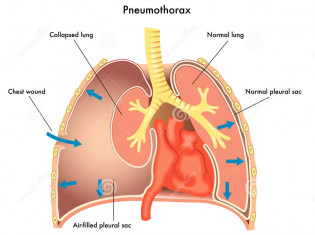Pneumothorax (collapsed lung)
What is a pneumothorax?
— A pneumothorax happens when air leaks out of the lung and collects in the space between the lung and the chest wall. This makes the lung collapse.
Other conditions can also cause a collapsed lung. But this article discusses a collapsed lung caused by air leaking out.
A pneumothorax can be mild (a small collection of air) or severe (a large collection of air). A severe pneumothorax is a medical emergency and can be life-threatening.
What causes a pneumothorax?
— A lung injury, such as from an accident or surgery, can cause a pneumothorax.
A pneumothorax can also happen in people who do not have a lung injury. Some lung conditions and behaviors make a pneumothorax more likely to happen. These include:
- Chronic obstructive pulmonary disease – This is a lung condition caused by smoking that makes it hard to breathe. It is also called “emphysema.”
- Certain lung infections
- Cystic fibrosis – This is a condition that some children are born with. It causes lung damage and lung infections.
- Smoking
Sometimes, a pneumothorax happens in people who have no known lung condition or injury.
What are the symptoms of a pneumothorax?
— People with a small pneumothorax might not have any symptoms. They might find out that they have it when they have a chest X-ray for another reason.
When people do have symptoms, the symptoms usually start suddenly and include:
- Chest pain that can be sharp or stabbing
- Trouble breathing
Should I call the doctor or nurse?
— Yes. The symptoms listed above can also be caused by other conditions. But if you have these symptoms, call your doctor or nurse right away.
Is there a test for a pneumothorax?
— Yes. Your doctor or nurse will ask about your symptoms, do an exam, and do a chest X-ray.
He or she might also do a CT scan. A CT scan is an imaging test that can create pictures of the inside of the body.
How is a pneumothorax treated?
— Your treatment will depend on your symptoms and how small or big your pneumothorax is.
If your pneumothorax is small, your doctor might treat you by giving you oxygen and following your condition. That’s because a small pneumothorax sometimes gets better on its own. To follow your condition, your doctor might do a few chest X-rays over time.
If your pneumothorax is large or causing symptoms, your doctor will remove the air that has collected outside of your lung. He or she can do this in different ways:
- Sometimes, the doctor can put a needle through your ribs, then suck out the air using a syringe.
- Other times, your doctor will make a small hole in between your ribs. He or she will put a tube through the hole and into the collection of air. The tube will stay in your chest for a few days.
If your doctor uses a large tube (called a “chest tube”), you will need to stay in the hospital while it is in your chest. If your doctor uses a small tube, you might be able to go home during this time.
If this procedure doesn’t work, your doctor might need to do lung surgery to close off the air leak. This surgery is called “thoracoscopy.” During thoracoscopy, the doctor will give you medicine to make you sleep. Then he or she will make 2 or 3 small cuts between the ribs in your chest. He or she will put long, thin tools in these openings and into the space where the air collected. One of the tools has a camera on the end, which sends pictures to a TV screen. The doctor can look at the image on the screen to do the surgery.
If you need thoracoscopy to treat your pneumothorax, your doctor might do another surgical procedure during thoracoscopy to help prevent a future pneumothorax. He or she might also do this procedure if you have had more than one pneumothorax, even if the air leak stopped quickly.
Another way to help prevent a future pneumothorax is for your doctor to put a substance in your chest tube. This substance goes into the space where the air collected and helps the lung stick to the chest wall. This helps prevent air from collecting again.
What else should I do after treatment?
— If you smoke, you should stop smoking. This can help lower your chance of getting another pneumothorax.
You should also ask your doctor when you can fly in an airplane or go scuba diving. Some people need to wait a certain amount of time after treatment before it’s safe for them to fly or go scuba diving.

